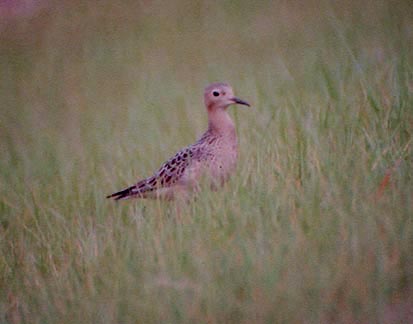I called up Arlene Koch and asked her permission to walk her property later that day. She told me that she would not be home then, but that it was fine for me to bird there. I was seeing the usual, expected birds as I walked the fields near the barn. Then, I noticed a bird in a tree with a few American Goldfinches that made me scratch my head. The head pattern was black and white, somewhat reminiscent of a chickadee, but it had a bright orange bill. I took some photos of it and sent the roll of film in for processing. I eventually got the slides back and went through my guides. Nothing came close, so I figured it wasn't a North American bird. I sent the photos out to a few other birders, and Nick Pulcinella came through with the answer. The bird was a Pin-tailed Whydah, which meant it was most likely an escaped cage bird. Here are the poor photos that I got of it.
With more exploration, I figured out that the bird was a young male, so it didn't have the long tail streamers of the adult. Still, it was a surprising find.
Friday, September 24, 2004
Friday, September 17, 2004
Buff-breasted Sandpiper in Northampton County! ~ September 16, 2004
On the 13th, Dan Altif found a Buff-breasted Sandpiper at the Hanoverville Road retention ponds. I went over and snapped a few photos of this new county bird for me.
Buff-breasted Sandpiper at the Hanoverville Road retention ponds in Northampton County. Note the dark eye on the small, buffy, 'dove-like' head, the short bill, the feathers' white edges, and the paler underparts toward the tail. This bird represents the 2nd Northampton County record.
Buff-breasted Sandpiper at the Hanoverville Road retention ponds in Northampton County. Note the dark 'comma' at the wrist of the otherwise white underwings. This bird represents the 2nd Northampton County record.
Another unusual bird, a Baird's Sandpiper was also present. Here's a long-range photo of that bird.
Baird's Sandpiper at the Hanoverville Road retention ponds in Northampton County. Note the buffy breast, the scaly-looking back, and the long wingtip extension.
Another unusual bird, a Baird's Sandpiper was also present. Here's a long-range photo of that bird.
Subscribe to:
Comments (Atom)






